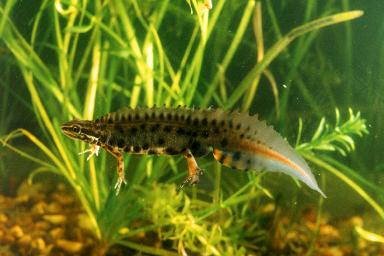


|
Salamandridae:
Small to medium sized (Salamandra and Pleurodeles reach more than 200 mm) terrestrial or aquatic salamanders. Mostly distributed throughout Europe and Asia, although the distribution of Salamandra and Pleurodeles reaches North Africa, and the genera Notophthalmus and Taricha are endemic to North America. Most species have toxic skin secretions. Many salamandrids develop dorsal body and tail fins when they return to an aquatic stage, while rough skin is present in the adult newts. Lungs are present in juveniles and adults. Salamandrids achieve internal fertilization through the use of a spermatophore which the male induces the female to take up through a courtship dance. Some morphological characters for the group are: 1) vomerine teeth extend posteriorly on lateral edges of vomers; 2) frontal-squamosal arch present; 3) vertebrae opisthocoelous.
Genus Calotriton (2 species)
Genus Chioglossa (1 species)
Genus Cynops (7 species)
Genus Echinotriton (2 species)
Genus Euproctus (2 species)
Genus Lissotriton (5 species)
Genus Lyciasalamandra (7 species)
Genus Mertensiella (1 species)
Genus Mesotriton (1 species)
Genus Neurergus (4 species)
Genus Notophthalmus (3 species)
Genus Ommatotriton (2 species)
Genus Pachytriton (2 species)
Genus Paramesotriton (7 species)
Genus Pleurodeles (3 species)
Genus Salamandra (6 species)
Genus Salamandrina (2 species)
Genus Taricha (3 species)
Genus Triturus (6 species)
Genus Tylototriton (8 species)
|
